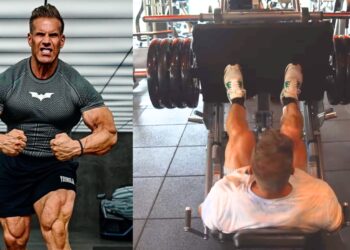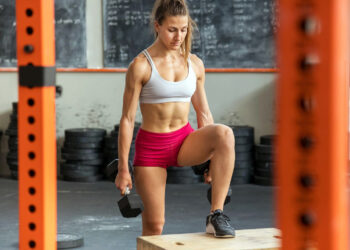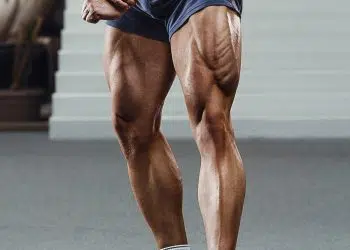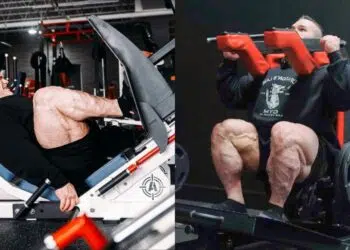Ask almost bodybuilder or powerlifter what the best leg size and strength exercise is, and invariably they’ll tell you it’s squats. It’s pretty hard to argue with such a sentiment. After all, squats are often called the king of exercises, and that’s a title they probably deserve.
Whatever goal you are training for, squats will help you get there faster. Squats are one of the best exercises for building massive legs, can help you build superhero strength and improve athleticism. You can also use squats to burn fat and, if you’ve ever done old-school 20-rep squats, you’ll already know that they can even improve your cardiorespiratory fitness, too.
But, while there is no denying the transformative power of squats, they do have their limits and drawbacks.
For starters, if all you ever do is squats, your workouts can soon become boring. Also, heavy squats put a lot of stress on your lower back, which may be a problem for some exercisers.
None of this means you need to quit squats – almost everyone who lifts should squat hard and heavy. But it may be worth supplementing your squat workouts with some additional exercises.
Leg presses are a good option, and in this article, we’re going to reveal 11 new ways to use this productive lower body exercise.
Level Up Your Fitness: Join our 💪 strong community in Fitness Volt Newsletter. Get daily inspiration, expert-backed workouts, nutrition tips, the latest in strength sports, and the support you need to reach your goals. Subscribe for free!
Leg Press 101
You are probably already very familiar with leg presses but, for the sake of clarity, in this section, we’re going to outline the advantages and benefits of leg press training.
Safety– while no exercise is 100% safe, the leg press is one of the safest, especially when you use it properly. Unlike squats, a failed rep won’t leave you pinned under a heavy weight. All you need to do is flip the weight catchers in when you have reached your limit. Squatting to failure is a hazardous undertaking, especially if you aren’t in a squat rack. In contrast, you can train to failure on a leg press in relative safety.
Back support– when you squat, you have to use your core and back to maintain proper spinal alignment. As these muscles start to fatigue, your lower back will begin to round, and, combined with the heavy weight on your shoulders, this can cause lower back pain and injury.
Leg presses provide your lower back with some welcome support, allowing you to lift heavier weights and without your back limiting performance.
Easy to learn– squats are quite a technical exercise. It takes time to learn how to squat properly. Because of poor biomechanics, some people never really get to grips with the intricacies of good squatting form. Squatting heavy weights with poor technique is likely to lead to injury. Leg presses are much simpler, and most people can master this exercise within a couple of workouts.
Check out this in-depth guide on how to leg press correctly.
Simplicity– less technical lifts like leg presses aren’t just useful for beginners; they’re good for intermediate and advanced lifters too. Because they’re something of a no-brainer, you are free to focus entirely on your set, pushing yourself to the limit. This can be useful when your goal is building maximal muscle size.
Of course, there are a couple of leg press drawbacks too…
A false sense of security– while leg presses are relatively safe, you still need to do them properly to avoid injury. The main issue is bending the knees too far, which causes the lower back to become rounded. Make sure you press your lower back into the backrest and stop your set if your hips start to tilt upward.
Not as functional– a functional exercise has an obvious carry-over to everyday movements or sporting activities. Squats aren’t just an exercise; they’re also a common movement that most people do many times a day. Leg presses, which involve lifting a heavy weight while seated or lying on your back, are not as functional. That’s why, for most people, leg presses should be a supplement to and not a replacement for squats and other freestanding leg exercises.
Left-to-right strength imbalances – it’s usually quite easy to see if you have one leg stronger during squats. The weight will shift toward your stronger side, and you may even notice that one knee tracks differently. Because the weights are guided on rods, it’s harder to spot left-to-right imbalances on leg presses. As such, if you overuse this exercise, any strength discrepancies could go unnoticed and uncorrected.
Boredom– when it comes to leg presses, most people do the same old three sets of ten or four sets of eight that they use for the rest of their workout. This lack of variety can mean that leg presses are not as exciting as other exercises, such as squats. After all, there are LOADS of ways to make your squat workout more interesting, such as front squats, box squats, wide-stance squats, goblet squats, pistol squats, etc.
However, to save you from leg press boredom, in the following section, we’re going to reveal 11 new ways to use this machine.
New Ways to Use the Leg Press Machine
Use these methods to make your leg press workouts more interesting and productive. Be warned, some of them are pretty tough, so start light and expect some post-workout muscle soreness.
1. Run The Rack Leg Press
Run the rack training works really well with dumbbells for biceps curls. The idea is simple; start with the lightest dumbbells and pump out a rep of biceps curls. Set the weights down, move up to the next pair, and do another set.
Continue up the rack until you hit failure. Then work back down the rack, reducing the weight each time, until you arrive back where you started with the lightest dumbbells.
For example:
- 10 reps – 5lbs
- 10 reps – 10lbs
- 10 reps – 15lbs
- 10 reps – 20lbs
- 10 reps – 25lbs
- 10 reps – 30lbs
- 10 reps – 35 lbs
- 10 reps – 30lbs
- 10 reps – 25lbs
- 10 reps – 20lbs
- 10 reps – 15lbs
- 10 reps – 10lbs
- 10 reps – 5lbs
This training method produces a massive pump and is a great way to end your arm workout. You can use the same method on leg presses, but you’ll need a couple of willing training partners to lend a hand and load the weights…
How to do it:
Level Up Your Fitness: Join our 💪 strong community in Fitness Volt Newsletter. Get daily inspiration, expert-backed workouts, nutrition tips, the latest in strength sports, and the support you need to reach your goals. Subscribe for free!
- Sit on your leg press machine. Do ten reps with no weight. End your set with your legs extended. At this point, your partners should add a 45-pound plate to each side.
- Pump out another set of ten reps. Pause and let your partners add another 45-pound plate per side.
- Continue in this manner until you can do no more sets of ten.
- Remove 45-pounds from each side and push out ten reps.
- Continue decreasing the weight every ten reps until all the plates have been removed.
- You can also do this method on your own if you have a selectorized weight stack leg press.
2. Leg Press 21s
Like running the rack, 21s are usually associated with biceps training. However, it’s a method you can use with leg presses too. 21s, also known as the matrix system, increases time under tension (TUT) and causes more occlusion, creating metabolic overload and a great pump, both of which are triggers for muscle growth.
How to do it:
- Load your leg press and press the weight up. This is your starting position.
- Bend your knees and lower the weight halfway down. Push it back up again and repeat seven times.
- Next, from halfway down, lower the weight as far as you can without rounding your lower back, and then push it halfway up. Repeat seven times.
- Finally, do seven full reps to total 21.
3. Leg Press Two Up, One Down
You are stronger eccentrically than you are concentrically. This means you can lower more weight than you can lift. The two up, one down method makes the most of this phenomenon.
How to do it:
- Load your leg press and press the weight up.
- Move one leg out of the way and slowly lower the weight using the other leg. Take 3-5 seconds to descend.
- Push the weight up with both legs, and then lower it again using the other leg.
- Continue alternating legs until you are unable to control the rate of descent.
4. Leg Press with Bands
Using bands increases the resistance at the end of each rep when the tension usually decreases. Banded leg presses make locking out your knees much harder, increasing quadriceps recruitment and changing the feel of this exercise. The added variety may help trigger new muscle growth and increases in strength.
How to do it:
- Attach strong resistance bands to the weight carriage and the bottom of your leg press machine. Ensure the bands will not interfere with the operation of the safety catches or get caught up on the weight guides. Load the leg press with less weight than usual, as the bands will add to the overload.
- Sit on the leg press and press the weight up. Lift explosively to maximize muscle recruitment.
- Lower the weight under control and repeat.
5. Paused Leg Press
Powerlifters use paused reps to build strength and power. It’s also a useful strategy for building muscle, as it increases time under tension. Paused leg presses should have the same benefit, but you’ll be free to focus on training closer to failure for a more intense workout.
How to do it:
- Load your leg press and press the weight up.
- Bend your legs and lower the weight as far as you can without rounding your back.
- Pause in this position for 3-5 seconds. Do not relax!
- Drive the weight back up and repeat.
6. Leg Press Breathing Pyramid
This leg press workout is both simple and brutal. It’s a great way to close out your lower body workout, and you should only need to do one extended set. Just keep going until you are unable to continue. And yes, burning quads and gasping for breath is entirely normal!
How to do it:
- Load your leg press and press the weight up. This is your starting position.
- Do one full rep, and then take a deep breath. Do not rerack the weight.
- Do two reps and take two breaths.
- Do three reps and take three breaths.
- Keep going until you are unable to continue.
7. Leg Press Myo-reps
Myo-reps are a very intense, time-efficient training method for building muscle. It’s a type of rest-pause training that keeps your muscles close to failure for longer than standard set and rep schemes. Use this training method whenever you are short of time but still want a productive lower body workout.
How to do it:
- Load the leg press with a weight you can 12-20 times. When you are ready, pump out as many reps as you can. Rack the weight.
- Rest 15-20 seconds, and then do 25% of the reps you did in your first set. So, if you did 16 reps, push out an additional four reps.
- Rest 15-20 seconds, and do another four reps.
- Continue until you are a) unable to do four reps or b) complete five sets of four reps.
8. Narrow to Wide-leg Presses
Wide leg presses emphasize your inner thighs, while narrow leg presses are more quad-centric. This leg press method combines several different foot positions to hit your legs from multiple angles.
How to do it:
- Load up your leg press. With your feet close together, press the weight up. This is your starting position.
- Rep out to within a couple of reps of failure.
- Move your feet out and adopt a medium-width stance.
- Again, rep out to within a couple of reps of failure.
- Finally, move your feet out and adopt a wide stance, toes turned slightly outward.
- Rep out to failure and then rerack the weight.
9. Leg Press/Squat Jump/Bodyweight Squat Triset
Just because you have reached leg press failure doesn’t mean your muscles are completely exhausted. This triset is designed to activate the maximum number of muscle fibers and motor units to trigger even more muscle growth.
How to do it:
- Load up your leg press and then rep out to within 1-2 reps of failure. Rerack the weight and quickly stand up next to your machine.
- With your feet about shoulder-width apart and using your arms for extra momentum, squat down and then jump into the air as high as you can. Continue until your jump height starts to noticeably decrease.
- Finally, pump out as many bodyweight squats as you can.
10. 1 ½ Rep Leg Presses
This leg press variation increases time under tension (TUT), which is the time it takes to complete your set. Longer TUTs can help build muscle size and improve muscular endurance. There are two ways to do 1 ½ rep leg presses. Method one overloads your quads, while method two increases glute and hamstring recruitment.
How to do it:
- Load your leg press and press the weight up. This is your starting position.
- Lower the weight as far as you can without rounding your lower back. Push it back up.
- Next, bend your legs and lower the weight halfway down. Press it back up.
- Repeat this full rep/half rep sequence until you are within a rep or two of failure.
Alternatively, you can do your extra half rep at the bottom of the movement to work your hamstrings and glutes more.
11. 100 Rep Leg Press Challenge
High-rep training has been shown to be an effective way to build muscle mass (1). However, doing lots of reps of a complex exercise likes squats or lunges is a good way to get injured, as your technique is bound to falter as you start to get tired. That’s what makes high-rep leg presses so valuable; you’re free to focus on just pumping out the reps.
How to do it:
- This training method is simple – just do 100 non-stop reps of leg press. Don’t put any weight on your leg press machine. The weight of the carriage will probably be enough.
- You can rest with your legs extended, but you are not allowed to rack the weight.
- Make this training method even more effective (and painful) with blood flow restriction
Wrapping Up
A lot of training experts are very quick to dismiss the leg press because it’s not as functional and squats and lunges. While this statement is true, it’s also worth remembering that functional means different things to different people. After all, if you are a bodybuilder, you want exercises that maximize hypertrophy – and that’s one of the potential functions of the leg press.
Squats deserve the title of king of exercises, but that doesn’t mean leg presses aren’t valuable, too. In fact, you may find that they have a few advantages that squats do not share.
So, squat hard and heavy, but make your leg workouts even more productive with leg presses. Use these new training methods to keep your lower body workouts fresh and interesting. After all, your body will soon adapt if you do the same workouts over and over. Boredom is the enemy of effective training!
References:
1 – PubMed: Low-Load High Volume Resistance Exercise Stimulates Muscle Protein Synthesis More Than High-Load Low Volume Resistance Exercise in Young Men https://pubmed.ncbi.nlm.nih.gov/20711498/









